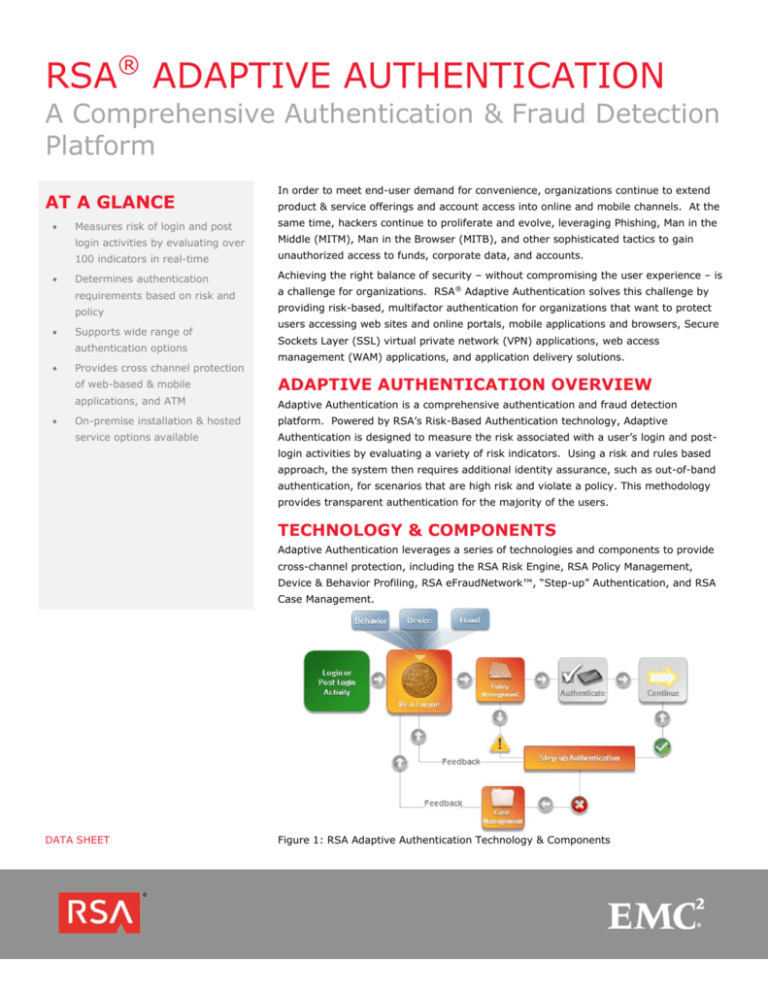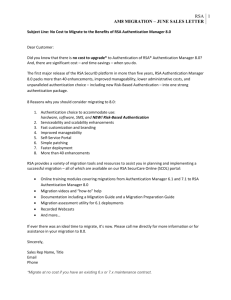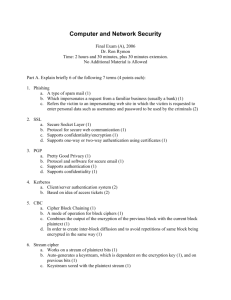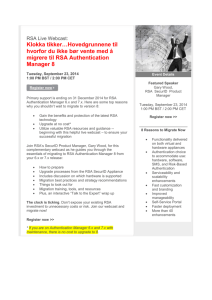
RSA® ADAPTIVE AUTHENTICATION
A Comprehensive Authentication & Fraud Detection
Platform
AT A GLANCE
product & service offerings and account access into online and mobile channels. At the
Measures risk of login and post
same time, hackers continue to proliferate and evolve, leveraging Phishing, Man in the
login activities by evaluating over
Middle (MITM), Man in the Browser (MITB), and other sophisticated tactics to gain
100 indicators in real-time
unauthorized access to funds, corporate data, and accounts.
Determines authentication
Achieving the right balance of security – without compromising the user experience – is
requirements based on risk and
a challenge for organizations. RSA® Adaptive Authentication solves this challenge by
policy
providing risk-based, multifactor authentication for organizations that want to protect
Supports wide range of
authentication options
In order to meet end-user demand for convenience, organizations continue to extend
Provides cross channel protection
users accessing web sites and online portals, mobile applications and browsers, Secure
Sockets Layer (SSL) virtual private network (VPN) applications, web access
management (WAM) applications, and application delivery solutions.
of web-based & mobile
ADAPTIVE AUTHENTICATION OVERVIEW
applications, and ATM
Adaptive Authentication is a comprehensive authentication and fraud detection
On-premise installation & hosted
platform. Powered by RSA’s Risk-Based Authentication technology, Adaptive
service options available
Authentication is designed to measure the risk associated with a user’s login and postlogin activities by evaluating a variety of risk indicators. Using a risk and rules based
approach, the system then requires additional identity assurance, such as out-of-band
authentication, for scenarios that are high risk and violate a policy. This methodology
provides transparent authentication for the majority of the users.
TECHNOLOGY & COMPONENTS
Adaptive Authentication leverages a series of technologies and components to provide
cross-channel protection, including the RSA Risk Engine, RSA Policy Management,
Device & Behavior Profiling, RSA eFraudNetwork™, “Step-up” Authentication, and RSA
Case Management.
DATA SHEET
Figure 1: RSA Adaptive Authentication Technology & Components
RSA Risk Engine
The RSA Risk Engine is a self-learning statistical machine learning technology that
utilizes over 100 indicators to evaluate the risk of an activity in real-time. Adaptive
Authentication leverages the Risk Engine to generate a unique score for each activity
that ranges from 0 to 1,000, where 1,000 indicates the greatest level of risk. The
score is reflective of device profiling, behavioral profiling, and eFraudNetwork data.
The Risk Engine combines rich data input, machine learning methods and
authentication feedback to provide intelligent, real-time risk evaluations to mitigate
fraud. Unlike most solutions, RSA takes both a risk and rules based approach.
Customers can utilize the Policy Management application to set policy rules and that
can be layered on top of the Risk Engine to create a hybrid approach.
RSA Policy Manager
The RSA Policy Management application translates risk policies into decisions and
actions through the use of a comprehensive rules framework. For example, the Policy
Management application can be used to set the risk score that will require later review
in the Case Management application, prompt additional assurance or “Step-up”
Authentication, and/or deny transactions in which the likelihood of fraud is very high.
In addition, the Policy Management application can create rules independently of the
risk assessment, such as blocking authentication from a specific IP address.
Device Profiling
Device profiling analyzes the device from which the user is accessing an organization’s
website or mobile application. Adaptive Authentication determines whether a device
used for a given activity is a device that is typically used by the user, or if the device
has been connected to previous fraudulent activities. Parameters analyzed include
characteristics such as operating system version, browser type and version, and
cookies and/or flash objects.
Behavior Profiling
Behavior profiling is a record of the typical activity for the user. Adaptive
Authentication compares the profile for the activity with the user’s usual behavior to
assess risk. The user profile is used to determine if the various activities are typical for
that user, or if the behavior is indicative of known fraudulent patterns. Parameters
examined include frequency, time of day and type of attempted activity.
RSA eFraudNetwork™
The RSA eFraudNetwork™ is a cross-functional repository of fraud patterns gleaned
from RSA’s extensive network of customers, internal research lab, ISPs, and third party
contributors across the globe. When fraudulent elements such as IP Address, Device
Fingerprint, and/or Payee (Mule) Account are identified, they are shared with the
eFraudNetwork. The eFraudNetwork provides direct feeds to the Risk Engine so when
an activity is attempted from a device or IP that appears in the repository, it will be
deemed high-risk.
Case Management
A highly effective fraud management tool that enables the tracking of activities that
trigger Policy Engine rules and determines if flagged activities are genuine or
fraudulent. Organizations use this information to take appropriate measures in a timely
manner and minimize the damage caused by fraudulent activities. The Case
Management application is also used to research cases and analyze fraud patterns,
which are essential when revising or developing new policy decision rules. Further, this
tool also enables an organization to provide feedback into the risk engine upon case
resolution.
The Case Management API is an interface of Adaptive Authentication Case Management
capabilities that allow an organization to share information with an external case
management system. Consolidating cases into one system provides an organization
with the ability to more efficiently confirm and resolve fraudulent activities.
Step-up Authentication
A step-up authentication is an additional factor or procedure that validates a user’s
identity, usually prompted by high risk transactions or according to policy rules. The
following are examples of out-of-the-box step-up authentication methods supported in
Adaptive Authentication:
Challenge Questions: Secret questions that have been selected & answered by
end user during enrollment.
Out-of-Band Authentication: Onetime passcode sent to the end user via phone call,
SMS text message or email. Transaction details can be included in the
communication to help prevent fraudulent activities.
Dynamic Knowledge-Based Authentication (KBA): Dynamic questions that are
unique to the end user, and generated from publically & commercially available
data in real-time.
Other third party authentication methods via the RSA Multi Credential Framework.
CROSS CHANNEL PROTECTION: WEB & MOBILE
Mobile Protection
The Proliferation of mobile devices brings opportunity as well as risk; however, mobile
applications that directly integrate Adaptive Authentication protect against
unauthorized access with minimal impact to the end user. Adaptive Authentication
offers a dedicated mobile risk model that includes capabilities such as location
awareness and mobile device identification. Location awareness detects the location of
the device using a series of time and geography based algorithms and can access
location data gathered through Wi-Fi, cell-tower triangulation, and GPS. Device
Adaptive Authentication can be directly
embedded in mobile devices through
the Software Development Kit (SDK)
identification captures characteristics such as device model, language, and screen size.
Anomalies such as locations or devices which are new to the user, are deemed high
risk. Additionally, devices that are Jailbroken/Rooted or emulated can be identified.
Adaptive Authentication offers integration through a web services call, or a Software
Development Kit (SDK) that allows developers to build controls directly into their
mobile applications. Supported platforms include Apple iOS, Android OS and
Blackberry OS. Developers of mobile applications for business, banking, e-commerce
and data access can now help increase security and confidence by integrating strong
risk-based authentication in their mobile offerings.
FLEXIBLE DEPLOYMENT & CONFIGURATION
RSA recognizes that no two organizations share the exact same user authentication
needs, and as a result, Adaptive Authentication offers a wide array of deployment,
configuration, and language options to meet the varied needs of organizations. For
instance, organizations currently deploy Adaptive Authentication in two ways – as an
on-premise installation that uses existing IT infrastructure or as a hosted Software-asa-Service (SaaS). Further, Adaptive Authentication can be configured in a number of
ways to balance security and risk without compromising the user experience. Many
organizations currently provide risk-based authentication for their entire user base and
use the Policy Management application to determine action to take based on risk.
Lastly, the user interface and input & output fields are localized and internationalized to
support over 8 languages. This flexibility enables Adaptive Authentication be used to
protect a variety of remote access points such as web portals, SSL VPNs, and ATMs.
A PROVEN SOLUTION
Adaptive Authentication is a comprehensive, risk-based authentication and fraud
detection platform that balances security, usability, and cost. Further, Adaptive
Authentication helps to increases user confidence and willingness to transact with
VISIT THE RSA
STORE
Get a quote for RSA Adaptive
Authentication today.
store.emc.com/rsa
Adaptive Authentication is deployed at
over 8,000 organizations worldwide
online portals and mobile devices. Adaptive Authentication is a proven solution that is
currently deployed at over 8,000 organizations worldwide and across multiple
industries including financial services, healthcare, and government. It is currently being
used to protect over 200 million online users and has processed and protected over 20
billion transactions.
EMC2, EMC, the EMC logo, and RSA are registered trademarks or trademarks of EMC Corporation in
the United States and other countries. VMware is a registered trademark of VMware, Inc., in the
United States and other jurisdictions. © Copyright 2013 EMC Corporation. All rights reserved.
Published in the USA. 0113 Data Sheet H11429
EMC believes the information in this document is accurate as of its publication date.
The information is subject to change without notice.
CONTACT US
To learn more about how EMC
products, services, and solutions can
help solve your business and IT
challenges, contact your local
representative or authorized reseller—
or visit us at www.EMC.com/rsa
www.EMC.com/rsa









